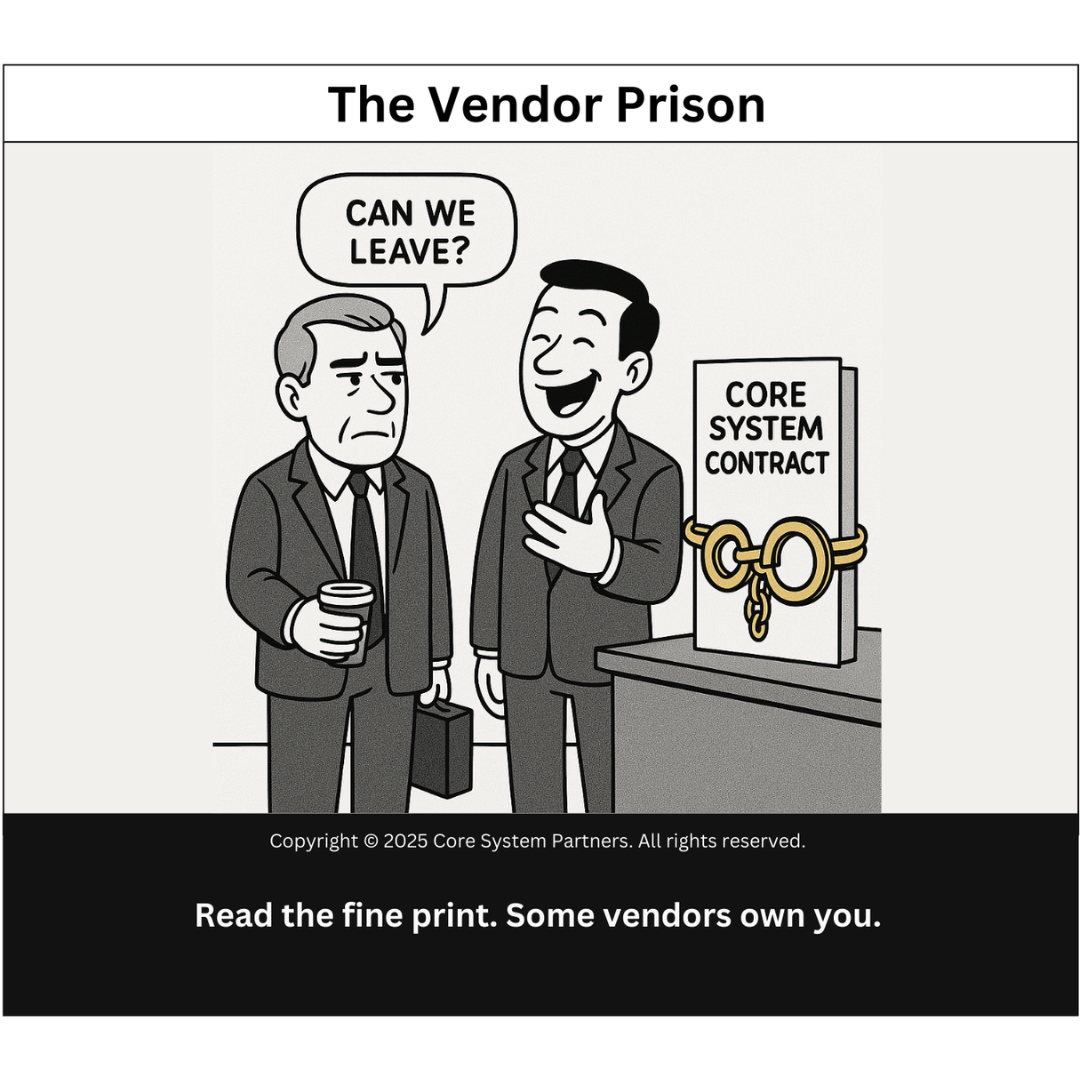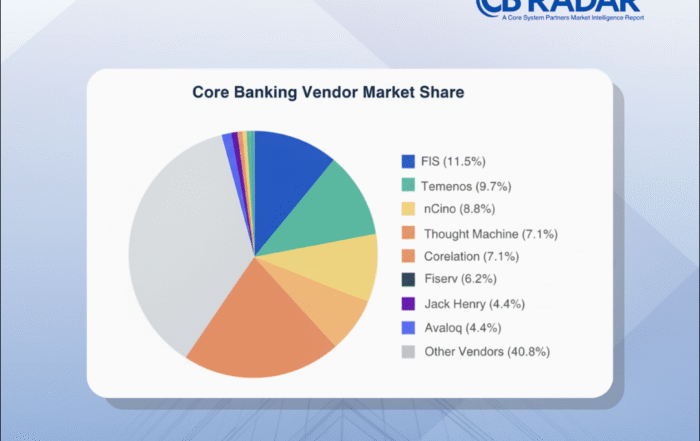
This cartoon titled “The Vendor Prison” humorously illustrates the serious issue of vendor lock-in in core banking systems. One executive asks, “Can we leave?” while another laughs beside a chained contract labeled “Core System Contract.” The visual metaphor highlights how restrictive contracts and proprietary systems can trap banks in long-term commitments with little flexibility. The caption—“Read the fine print. Some vendors own you.”—serves as a warning about the importance of negotiating vendor agreements with care.
Let’s talk about a conversation that happens more often in banking boardrooms than we’d like to admit.
“Can we leave?”
A reasonable question. But when it comes to core banking platforms, the answer is often a quiet, uncomfortable shuffle of papers, a nervous laugh, or a contract with enough legalese to make a compliance officer weep.
If the cartoon above hits a little too close to home, you’re not alone. And you’re not stuck—at least, not forever. But it’s time we had a serious conversation about vendor lock-in and how to avoid waking up one day to realize you’re handcuffed to a platform that no longer serves your strategy.
What Exactly Is Vendor Lock-In?
At its core (pun fully intended), vendor lock-in happens when a bank becomes overly dependent on a particular software provider—so much so that switching away feels practically impossible. Sometimes it’s a result of:
- Multi-year contracts with aggressive auto-renew clauses
- Proprietary technology that’s hard to decouple
- High switching costs (both technical and organizational)
- Limited interoperability with other platforms
- A lack of internal understanding about what’s under the hood
It’s one thing to have a strong relationship with your vendor. It’s another when the vendor relationship starts to feel more like a sentence than a partnership.
How We Get Trapped
(And Why It Happens So Often)
Here’s the kicker: most banks don’t walk into a vendor relationship expecting to get boxed in. But over time, things shift.
- What started as a 3-year contract becomes a 10-year entanglement.
- A few customizations snowball into hundreds of unique configurations.
- You build workarounds instead of negotiating capabilities.
- Support costs climb—but exit fees climb higher.
We once worked with a mid-tier bank that had layered so many ancillary services onto its core provider that leaving would’ve required 18 months and a full rebuild of their customer portal. They weren’t unprepared. They were uninformed—until it was too late.
The Real Risks of Vendor Dependence
Being overly reliant on a single core provider introduces more than a little inconvenience. It creates real operational and strategic risks.
1. Innovation Paralysis
You can’t implement a new feature or capability unless the vendor supports it—or worse, unless you pay for a costly custom dev cycle.
2. Budget Drain
License renewals, maintenance, and surprise fees add up quickly. And when you’re locked in, leverage disappears.
3. Security Gaps
You might not even know how well your vendor protects sensitive data—or whether their practices align with your standards.
4. Inflexibility During Change
Whether you’re expanding, merging, or pivoting your strategy, you’ll need systems that flex with you. A vendor that won’t budge becomes a liability.
How to Break Free
(or Never Get Stuck in the First Place)
The goal isn’t to make vendors the enemy. Many are fantastic partners. But we do need to get savvier in how we manage those relationships—and structure those contracts.
Here’s how:
1. Negotiate from Day One
- Push for exit flexibility clauses.
- Cap fees, define service levels, and clarify ownership of data and custom code.
- If the contract language makes you feel like you’re signing away your firstborn, walk away.
2. Prioritize Open Architectures
Favor vendors who support:
- Open APIs
- Cloud-native services
- Interoperability with other platforms
Open architecture makes it easier to migrate (or mix-and-match systems) down the road.
3. Maintain Technical Documentation
Know exactly what systems rely on your core provider—and how deeply. Don’t let your vendor own your institutional knowledge.
4. Avoid Customization Overload
Every customization may seem harmless, but over time, they compound into complexity that locks you in. Stick to configurable platforms when possible.
5. Conduct a Vendor Risk Review
At least annually. Include:
- Contract reviews
- Data ownership clarity
- Escalation pathways
- Plan B if things go sideways
As one CIO told us, “Our vendor contract had a change-of-control clause we completely overlooked. That became a problem during our merger.” Lesson learned.
If You’re Already in the Vendor Prison…
1. First: don’t panic.
There’s a path forward—but it requires deliberate planning.
Start with a core system disentanglement assessment:
- What systems, workflows, and data are dependent on the vendor?
- What alternatives exist in the market today?
- What capabilities are truly “sticky” vs. legacy processes that need modernization anyway?
Next, build a phased exit strategy:
- Step 1: isolate non-core components (like CRM or analytics)
- Step 2: replace modular components first
- Step 3: gradually reduce your dependency until a full core conversion is viable
And finally—build a business case that includes the cost of staying.
Opportunity cost is just as real as switching cost.
Final Thoughts:
The Contract Shouldn’t Be a Cage
Transformation is already hard. Don’t make it harder by chaining yourself to a partner who stops listening the moment the ink dries.
The right core banking vendor should empower your evolution, not prevent it.
So next time you review a contract—or inherit one—ask yourself:
- Can we leave?
- Can we grow?
- Can we adapt?
If the answer to any of those is “maybe” or “not really,” it’s time for a different conversation.
Your Next Step: How Free Are You, Really?
Our OptimizeCore® Scorecard helps you assess the level of vendor dependency in your stack—and offers practical steps to regain control.
#CoreBankingTransformation #CoreBankingOptimization





